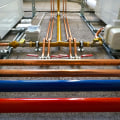When it comes to maintaining a healthy and efficient home, proper attic ventilation plays a crucial role. The best attic ventilation system can significantly impact the longevity of your roof, the comfort of your living space, and the overall energy efficiency of your home. Various ventilation options are available, each with its own advantages and ideal applications. Understanding these options and choosing the right one for your home involves considering factors such as climate, roof design, and existing ventilation systems.
One of the most popular and effective attic ventilation systems is the ridge vent. Ridge vents run along the peak of the roof, allowing hot, humid air to escape from the attic. When combined with soffit vents installed at the eaves, ridge vents create a continuous airflow through the attic space. This passive ventilation system relies on natural convection, where cool air enters through the soffit vents and pushes hot air out through the ridge vents. Ridge vents are often preferred for their unobtrusive appearance and efficiency in maintaining a balanced attic temperature.
Gable vents are another common type of attic ventilation. These vents are installed on the exterior walls of the attic, near the roof peak. Gable vents can be used alone or in combination with other ventilation systems, such as ridge vents or soffit vents, to enhance airflow. They are particularly effective in homes with gable roofs, as they can facilitate cross-ventilation when installed on opposite gable ends. While gable vents are relatively easy to install and can significantly improve attic ventilation, their effectiveness may be limited in more complex roof designs.
Roof turbines, also known as whirlybirds, are another option for attic ventilation. These turbine vents are mounted on the roof and use wind power to spin and create a vacuum effect that pulls hot air out of the attic. Roof turbines can be very effective in windy areas, providing active ventilation without the need for electricity. However, their performance can be inconsistent in areas with low wind speeds, and they may require regular maintenance to ensure optimal operation.
For homes in warmer climates, powered attic ventilators or attic fans can provide a more controlled and efficient solution. These fans are typically installed on the roof or gable walls and use electricity to actively pull hot air out of the attic. While powered attic fans can significantly reduce attic temperatures, thereby lowering cooling costs and extending the life of the roofing materials, they also consume energy. It is essential to balance the energy savings from reduced cooling costs against the electricity used by the fans. Proper installation by a professional, such as a Portland roofing company, can ensure that these fans operate efficiently and effectively.
Solar attic fans offer an eco-friendly alternative to traditional powered attic fans. These fans are powered by solar panels, which eliminate the need for electricity from the grid and reduce the overall energy consumption of the home. Solar attic fans can provide effective ventilation during the hottest parts of the day when attic temperatures are highest. While the initial cost of solar attic fans may be higher than other options, the long-term energy savings and environmental benefits make them an attractive choice for many homeowners.
Another consideration in choosing the best attic ventilation system is the specific climate and weather conditions of your area. In colder climates, proper attic ventilation is crucial to prevent moisture buildup and ice dams. Ice dams occur when heat escapes into the attic, causing snow on the roof to melt and refreeze at the eaves, leading to potential water damage. In warmer climates, attic ventilation helps reduce the heat load on the home’s cooling system, enhancing energy efficiency and comfort.
Regardless of the type of attic ventilation system chosen, regular maintenance and inspection are essential to ensure its effectiveness. Blocked or damaged vents can lead to poor ventilation, resulting in issues such as mold growth, increased energy costs, and reduced roof lifespan. Professional inspections and maintenance by a reputable roofing contractor can help identify and address any ventilation issues before they become significant problems.
In conclusion, the best attic ventilation system for a home depends on various factors, including the roof design, climate, and specific ventilation needs. Ridge vents, gable vents, roof turbines, powered attic ventilators, and solar attic fans each offer unique benefits and can be effective in different scenarios. Consulting with an experienced roofing professional, such as a Portland roofing company, can help homeowners make informed decisions and ensure that their attic ventilation system is properly installed and maintained for optimal performance. Proper attic ventilation is a key component in maintaining a healthy, efficient, and comfortable home environment.



